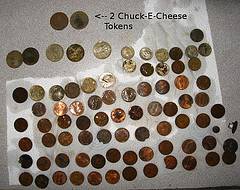Thanks to all who sent in their stories of gritty entrepreneurs. To those who just copied the standard PR spiel with an opening line about “gritty entrepreneurs”, please stop! We will be doing some interviews. Right now we are parsing through the incoming stories to classify and spot some trends.

The first big question that jumps out is: where are the profitable VC funded web ventures?
Lots Of Bootstrappers Out There
We heard from lots of gritty entrepreneurs building business the old fashioned way, keeping costs low and funding from revenue. I have done that and know how hard it is to do, so here is a big cheer of recognition for all who are going that route. I hope we can profile some in the future.
When you make it to profitability via bootstrapping, you have a wonderful independence and freedom. You have to keep clients happy every day, but you really do get to call the shots. You don’t have a money guy in the boardroom. This is why many people become entrepreneurs.
But what we want to focus on here are VC funded web 2.0 ventures that got to profitability as standalone ventures.
Surely Jigsaw is not the only one?!
We chose Jigsaw to kick off this series because they were VC funded and profitable. (Many people don’t like Jigsaw, it seems like a tool for spammers, but that is another story and a bit out of date from what we can see). The point here is, what other Web 2.0 companies have been funded by VC and have reached profitability? Surely there must be some more? Did all the 2003/2004 era Series A funded ventures either exit or fail? Or are some on the cusp of profitability, with enough investor cash to get them there? Even with revenue forecasts that may need to be to brought down as a result of a slowing economy?
Please tell us about any VC funded web 2.0 ventures that are profitable today standalone. Here are the hurdles:
- “VC Funded”. A minimum $3m Series A from a recognized VC fund.
- “Web 2.0 venture”. We will be as loose as possible in this definition. In fact, any web venture funded after 2002 is OK as any venture after that date is likely to have some features of user generated content, social media, SaaS or other 2.0ish characteristics. “Web 2.0” is like the definition of art “I cannot define it, but I know it when I see it and I know what I like”.
- “Profitable”. On this criteria we will be tight. We mean the Warren Buffet definition of profitable, which means “free cash flow”, otherwise known as “owner earnings”. It is really simple and you cannot fake it. You either get more cash from operations (cash from investors does NOT count) than you spend, or you don’t. Accounting conventions like EBITDA don’t count. More on this later.
- “Today”. That means this quarter. Even better last quarter. Or more than a few quarters.
- “Standalone”. Skype maybe profitable within EBay or YouTube within Google. That is a separate subject. We are looking for standalone ventures that have not exited. They made it to profitability on their own.
Why Free Cash Flow Is The Measure
EBITDA (Earnings Before Interest Taxation Depreciation and Amortization) is an accounting convention that is used a lot in the private equity business. “Private Equity” used to be known as “Leveraged Buyout”. The L word is not in vogue today (Ed, using understatement as humor seldom works). Seriously, Private Equity deals have been based on their ability to raise debt at low cost. That game is over for a while.
EBITDA is supposed to be a measure of how much debt you can put on a company. It is usually applicable to well established businesses in traditional industries. Recently it has been used in relation to Facebook and other large web ventures. This is where it gets interesting for web entrepreneurs and their investors.
Is Facebook Profitable?
According to a report in BoomTown in January 2008, based on an interview with Mark Zuckerberg:
“Revenue for Facebook for 2007 will be $150 million, as has been widely reported. But for 2008, Zuckerberg projected revenue to be increased to $300 million to $350 million.
More interesting was the news that Facebook would spend $200 million next year on capital expenditures, which is a whole lot of servers.
By the way, more expenses, noted chatty Mark, those employee levels would rise to more than 1,000 in 2008 from 450 now.
And Zuckerberg also said the company’s EBITDA-earnings before interest, taxes, depreciation and amortization and a number widely used by Wall Street as an indication of operating performance-would be $50 million in 2008.
That means the company would have a negative cash flow of about $150 million (EBITDA minus CapEx), rather than break even, as it does now.”
Is Facebook profitable today, in the last quarter of 2008? Well it is almost certainly EBITDA positive, butthat is not the true measure. The answer is “maybe”. If Facebook is hitting $300m to $350m this year (2008) and their operating costs have doubled from $50m to $100m (which is reasonable assumption as they said they would more than double employees from 450 to 1,000), they would have EBITDA of $200m to $250m. That sounds pretty good. But after $200m in Capex for servers, they are only breaking even on free cash flow at the bottom of their revenue forecast range. And, given the failure of Beacon and declining CPM rates on social networks, my guess (it is only a guess) is that Facebook revenues will be at the lower end of their forecast or even below.
But enough about Faceboom. The more generally interesting business issue highlighted by their story is that Capital Expenditure (“Capex”) does matter for web ventures. In fact, it is a mission critical issue, with good software design at the heart of the issue.
Servers Are An Operating Expense For Web 2.0 Ventures
With user generated content, you don’t pay people to create content that you use to generate advertising revenues. So your operating costs are R&D (developers), advertising sales and all those senior management overhead lumped into the General & Administrative (G&A) cost bucket. I don’t really understand what 1,000 people do at Facebook, but that is another story.
As you scale, people costs should not scale. Servers do need to scale. That is where Facebook must be suffering from some sloppy early software design. That is fine, the initial win is all about user traction and a scalable design is secondary. But today it is a critical issue for Facebook. It is also a critical issue for any venture starting out today. Spending a few bucks early on to get a scalable architecture seems sensible. This is not rocket science, any competent software architect knows how to do this.
Should Servers Be Outsourced Or Leased?
Capex sounds old-fashioned. Why buy servers when you can lease or rent? If Facebook leased rather than bought servers, they could have positive free cash flow even at the lower end of their revenue forecast. The credit crisis will make leasing a bit tougher. Renting via Hardware As A Service (HaaS) is the ideal route for startups you benefit from the scale of the HaaS vendor. But it is unclear how the economics scale for the buyer? It is unclear whether Amazon AWS or any other HaaS is a serious option at Facebook’s scale (or the scale of any VC funded venture that is nudging profitability).
Scale Or Profits – The New Choice?
It seems that ventures that can see a fairly quick way to profitability, simply ignore the VC route. The feeling seems to be mutual. VC look at a lot of the businesses that got to profitability and say “too small”.
So, you have to choose either big and unprofitable or small and profitable? That does not make sense. If that is true, is this an issue with Web 2.0 models? Some VCs have seen this as a failure of IPO markets, meaning that public market investors won’t trust unprofitable ventures promising they will be profitable in future. This “won’t get fooled again” view is natural after the Web 1.0 bubble burst.
Trade sales for unprofitable ventures are unlikely to be the solution in the next few years. Not good trade sales at any rate (fire sales are technically trade sales, but they are not a good result). The buyer will be much less willing to fund losses because their investors will be less willing to fund losses for an uncertain period of time. If the venture is close to profitability it does not need to exit and nobody wants to exit in a down market unless they have to. VC have plenty of cash so this is not a financing issue, if the path to profitability is clear.
Maybe profitability for a lot of Web 2.0 ventures is really close? Maybe it just takes longer for Web 2.0 ventures to get to profitable – but that they will be fantastic cash cows when they get there?
Image: mlitty

















